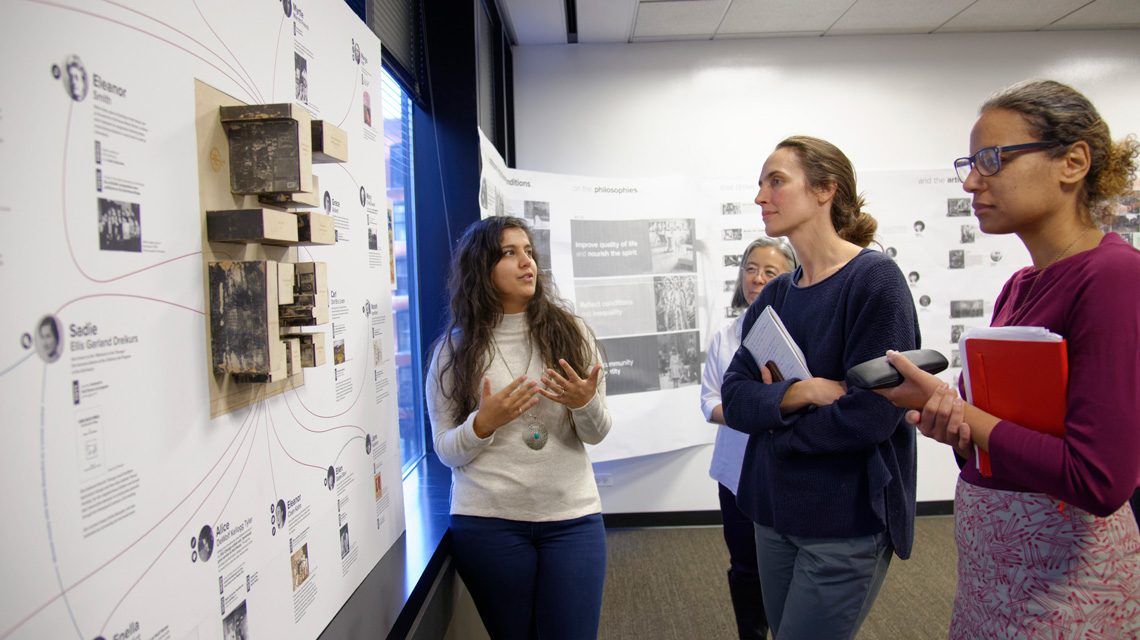Visualizing the Connections Between the Artists, the Community, and Influences at the Jane Addams Hull-House
December 1, 2017

Data abounds in bits and pieces in various sources and the visual designers’ role is often to create cohesive stories out of such discrete information. This was the challenge the students in the Fall 2017 Comm Design Workshop faced when trying to learn about the artists who worked and taught at the Jane Addams Hull-House settlement complex. The goal of the research was to produce visualizations that showed how the artists connected with each other, with the community they served, and the influence they held as a result of their endeavors.
The data-driven design project focused on deciphering, extracting, structuring, connecting and modeling the various forms of information it has about the artists who played a vital role in injecting humanity to the working community it served.
Jane Addams, a prominent social reformer, contributed greatly to Chicago’s immigrant community by establishing the Hull-House Settlements with Ellen Gates Starr, and developed its various social innovation programs to aid immigrants and laborers in the late 1800s – early 1900s. As part of its mission to care for the labor population in the area surrounding what is now University of Illinois Chicago, art was instilled in the community in multiple ways. Based on the philosophy of democratizing art, connecting the heart and hand, and as a way to counterbalance the indignities of brute conditions the laborers faced in the sweatshops of that area, art played a vital role in bringing a sense of humanity to the Hull-House and the people it served.
Making connections
The class ultimately generated four large-scale visualizations that looked at the concept of connection through different lenses; connections fostered by:
– Co-Occurrence: artists being at the Hull-House at the same time;
– Location: artists working in shared physical environments within the Hull-House complex;
– Historical context: art programs connected by their response to various historical events and movements;
– Philosophy: artists connected through their affiliation to shared philosophies.
The students created each visualization by hand, receiving inspiration from existing visualizations as well as wrestling with the particular variables presented in the data that they compiled and structured.
Research and challenge areas
The information about the various artists existed in various textual forms, from oral histories, newspaper articles, brochures, books and other written sources. The students collaboratively created several spreadsheets as they deciphered, extracted, and structured the literature, making shared datasets for all to reference. These spreadsheets consisted of chronological entries of events, artist directories, and connections between entities.
Prototype development
From there, each of the four teams used their particular lens to draw connections between the discrete pieces of information and modeled them through initial hand-drawn visualization sketches (i.e. hypothesis), evolving them through multiple iterations to final visualizations.
Next steps
The Museum is currently undergoing an effort to deliver a series of panel discussions, titled ‘Participatory Arts: The Legacy of Chicago’s Hull-House Artists’ in 2018 celebrating its legacy in art philosophy, art education, and art therapy. Ideally, the visualizations created in this workshop will be presented then. Students surveyed actual rooms in the Hull-House Museum to envision where they might fit within the context of the already existing exhibits. They were tasked to develop the visualizations with these eventual contexts in mind. Fundraising to be able to produce these visualizations is a main focus for the next steps.